Terrestrial and jovian - Study guides, Class notes & Summaries
Looking for the best study guides, study notes and summaries about Terrestrial and jovian? On this page you'll find 74 study documents about Terrestrial and jovian.
Page 3 out of 74 results
Sort by
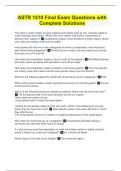
-
ASTR 1510 Final Exam Questions with Complete Solutions
- Exam (elaborations) • 13 pages • 2024
- Available in package deal
-
- $10.49
- + learn more
The earth is made mostly of rocky material and metals such as iron, whereas jupiter is motly hydrogen and helium. What is the main reason that Earth's composition is different from Jupiter's? Compared to Jupiter, Earth formed in a hotter region, where only rocks and metals could exist as solids most planets fall into one of two catergories in terms of composition. How would you best define these categories? Planets that are mostly rock and metal versus those that have a lot of H and HE How d...
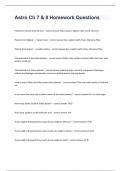
-
Astro Ch 7 & 8 Homework Questions and answers 2024 verified to pass
- Exam (elaborations) • 4 pages • 2024
- Available in package deal
-
- $13.49
- + learn more
Astro Ch 7 & 8 Homework Questions and answers 2024 verified to passAstro Ch 7 & 8 Homework Questions Farthest to closest from the Sun: - correct answer Pluto, Saturn, Jupiter, Mars, Earth, Mercury Planets from highest --> lowest mass: - correct answer Sun, Jupiter, Earth, Mars, Mercury, Pluto Planets from largest --> smallest radius: - correct answer Sun, Jupiter, Earth, Mars, Mercury, Pluto Characteristics of terrestrial planets: - correct answer Solid, rocky surface; locat...
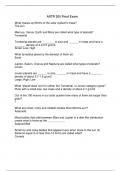
-
ASTR 205 Final Exam
- Exam (elaborations) • 7 pages • 2023
- Available in package deal
-
- $10.00
- + learn more
What makes up 99.8% of the solar system's mass? The sun Mercury, Venus, Earth and Mars are called what type of planets? Terrestrial Terrestrial planets are ________ in size and ______ in mass and have a _______ density of 3.9-5.5 g/cm3 Small; Low; High What terrestrial planet is the densest of them all. Earth Jupiter, Saturn, Uranus and Neptune are called what types of planets? Jovian Jovian planets are ______ is size, ______ in mass and have a _______ density of about 0.7-1...
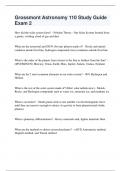
-
Grossmont Astronomy 110 Study Guide Exam 2
- Exam (elaborations) • 16 pages • 2024
- Available in package deal
-
- $14.49
- + learn more
How did the solar system form? - Nebular Theory - Our Solar System formed from a giants, swirling cloud of gas and dust What are the terrestrial and JSUN (Jovian) planets made of? - Rocks and metals condense inside frost line, hydrogen compounds (ices) condense outside frost line What is the order of the planets from closest to the Sun to farthest from the Sun? - (MVEM/JSUN) Mercury, Venus, Earth, Mars, Jupiter, Saturn, Uranus, Neptune What are the 2 most common elements in our solar sy...
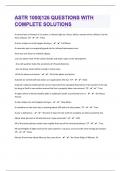
-
ASTR 1000|126 QUESTIONS WITH COMPLETE SOLUTIONS|2024
- Exam (elaborations) • 9 pages • 2024
-
- $7.99
- + learn more
A convex lens is thinnest in its center; it refracts light to a focus, while a convex mirror reflects it to the focus instead. T/F - ️️False A lunar eclipse can only happen during a: - ️️Full Moon A mountain top is an especially good site for infrared telescopes since: there you are closer to celestial objects. -you are above most of the carbon dioxide and water vapor in the atmosphere. -the cold weather helps the sensitivity of infrared detectors. -less air above means better se...
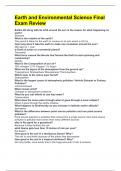
-
Earth and Environmental Science Final Exam Review
- Exam (elaborations) • 4 pages • 2023
- Available in package deal
-
- $9.69
- + learn more
Earth and Environmental Science Final Exam Review Earths tilt along with its orbit around the sun is the reason for what happening on earth? Seasons What is the rotation of the earth? The period it takes for the earth to revolve on its axis which is 24 hrs. How long does it take the earth to make one revolution around the sun? 360 days or 1 year Is Earth A jovian or a terrestrial planet? Terrestrial What force caused the Nevula that formed the Earth to start spinning and condensing? ...
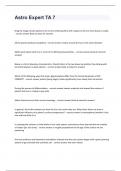
-
Astro Expert TA 7 Question and answers 100% correct 2024
- Exam (elaborations) • 3 pages • 2024
- Available in package deal
-
- $13.99
- + learn more
Astro Expert TA 7 Question and answers 100% correct 2024 Astro Expert TA 7 Drag the image of each planet to its correct orbital position with respect to the Sun (not drawn to scale). - correct answer (look at notes for answer) All the planets (without exception) - correct answer revolve around the Sun in the same direction Match each planet with one or more of its defining characteristics. - correct answer (look at notes for answer) Below is a list of planetary characteristics. Cl...
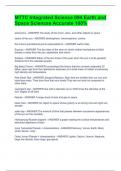
-
MTTC Integrated Science 094 Earth and Space Sciences Accurate 100%
- Exam (elaborations) • 7 pages • 2024
- Available in package deal
-
- $10.99
- + learn more
astronomy - ANSWER The study of the moon, stars, and other objects in space layers of the sun - ANSWER photosphere, chromosphere, corona the moons gravitational pull is responsible for - ANSWER earths tides Equinox - ANSWER The two days of the year on which neither hemisphere is tilted toward or away from the sun; september and march Solstice - ANSWER Either of the two times of the year when the sun is at its greatest distance from the celestial equator Big Bang Theory - ANSWER (c...
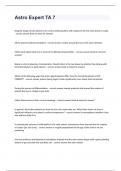
-
Astro Expert TA 7 with correct answers 2024
- Exam (elaborations) • 3 pages • 2024
- Available in package deal
-
- $9.99
- + learn more
Astro Expert TA 7Drag the image of each planet to its correct orbital position with respect to the Sun (not drawn to scale). - correct answer (look at notes for answer) All the planets (without exception) - correct answer revolve around the Sun in the same direction Match each planet with one or more of its defining characteristics. - correct answer (look at notes for answer) Below is a list of planetary characteristics. Classify them in the two boxes by whether they belong with terrest...
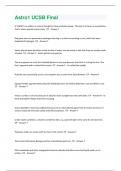
-
Astro1 UCSB Final Questions And Answers Rated A+ New Update Assured Satisfaction
- Exam (elaborations) • 6 pages • 2024
- Available in package deal
-
- $8.49
- + learn more
A THEORY is a pattern in nature thought to have predictive power. The test of a theory is a prediction. That's where pseudo-science fails. T/F - Answer-T Red giant stars are powered by hydrogen burning in a shell surrounding a core, which has been depleted of hydrogen. T/F - Answer-T Jovian planets have densities similar to that of water, and we know in fact that they are mostly made of water. T/F - Answer-F - Jovian planets are gaseous The Sun appears to circle the Celestial Sphere in on...

How did he do that? By selling his study resources on Stuvia. Try it yourself! Discover all about earning on Stuvia


